ICT704 Project: NoSQL Movie Database Design with MongoDB System
VerifiedAdded on 2023/06/07
|6
|1262
|181
Project
AI Summary
This document presents a movie database project implemented using MongoDB, a NoSQL database, designed for a web-based platform called Movie Maniacs. The project emphasizes the scalability and performance benefits of NoSQL databases over traditional relational models. The database structure includes a movie_collection, storing movie details like names, directors, actors, Oscar counts, and user reviews. The design incorporates embedding for reviews within the movie collection, though referencing is also discussed as an alternative. The project also suggests improvements such as storing user information separately and using references for relationships. The document also provides a performance comparison of SQL and NoSQL databases along with the references.
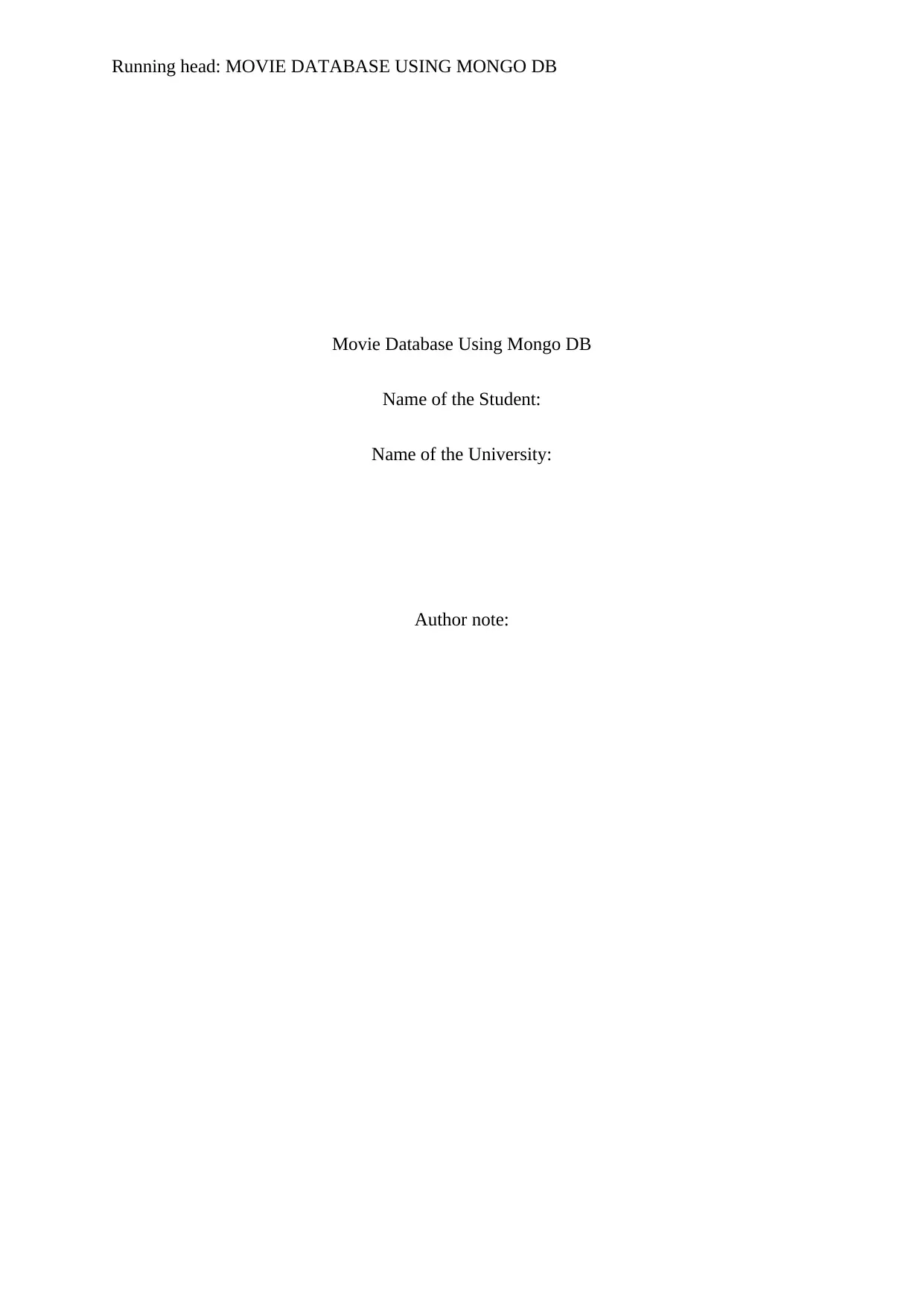
Running head: MOVIE DATABASE USING MONGO DB
Movie Database Using Mongo DB
Name of the Student:
Name of the University:
Author note:
Movie Database Using Mongo DB
Name of the Student:
Name of the University:
Author note:
Paraphrase This Document
Need a fresh take? Get an instant paraphrase of this document with our AI Paraphraser
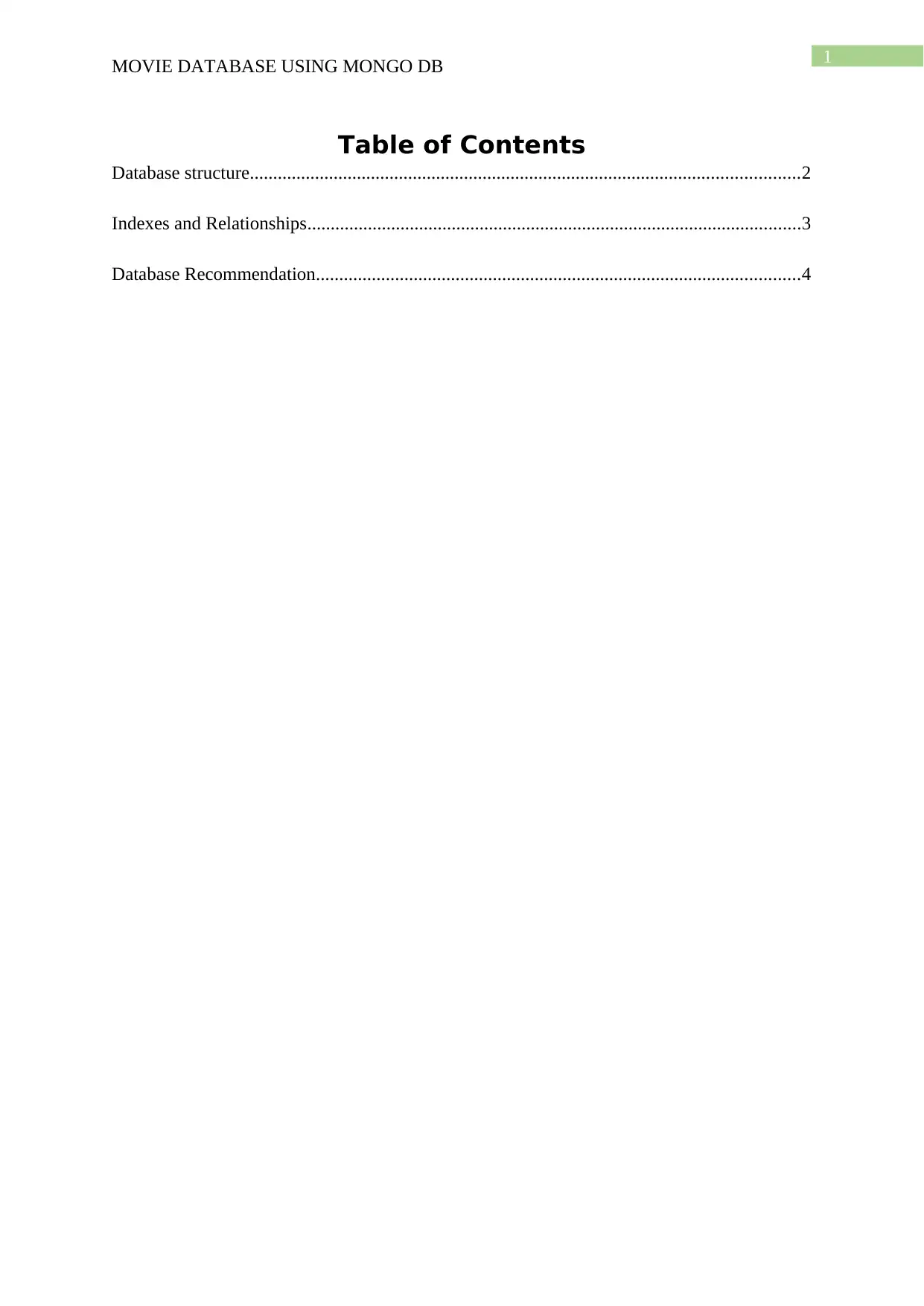
1
MOVIE DATABASE USING MONGO DB
Table of Contents
Database structure......................................................................................................................2
Indexes and Relationships..........................................................................................................3
Database Recommendation........................................................................................................4
MOVIE DATABASE USING MONGO DB
Table of Contents
Database structure......................................................................................................................2
Indexes and Relationships..........................................................................................................3
Database Recommendation........................................................................................................4
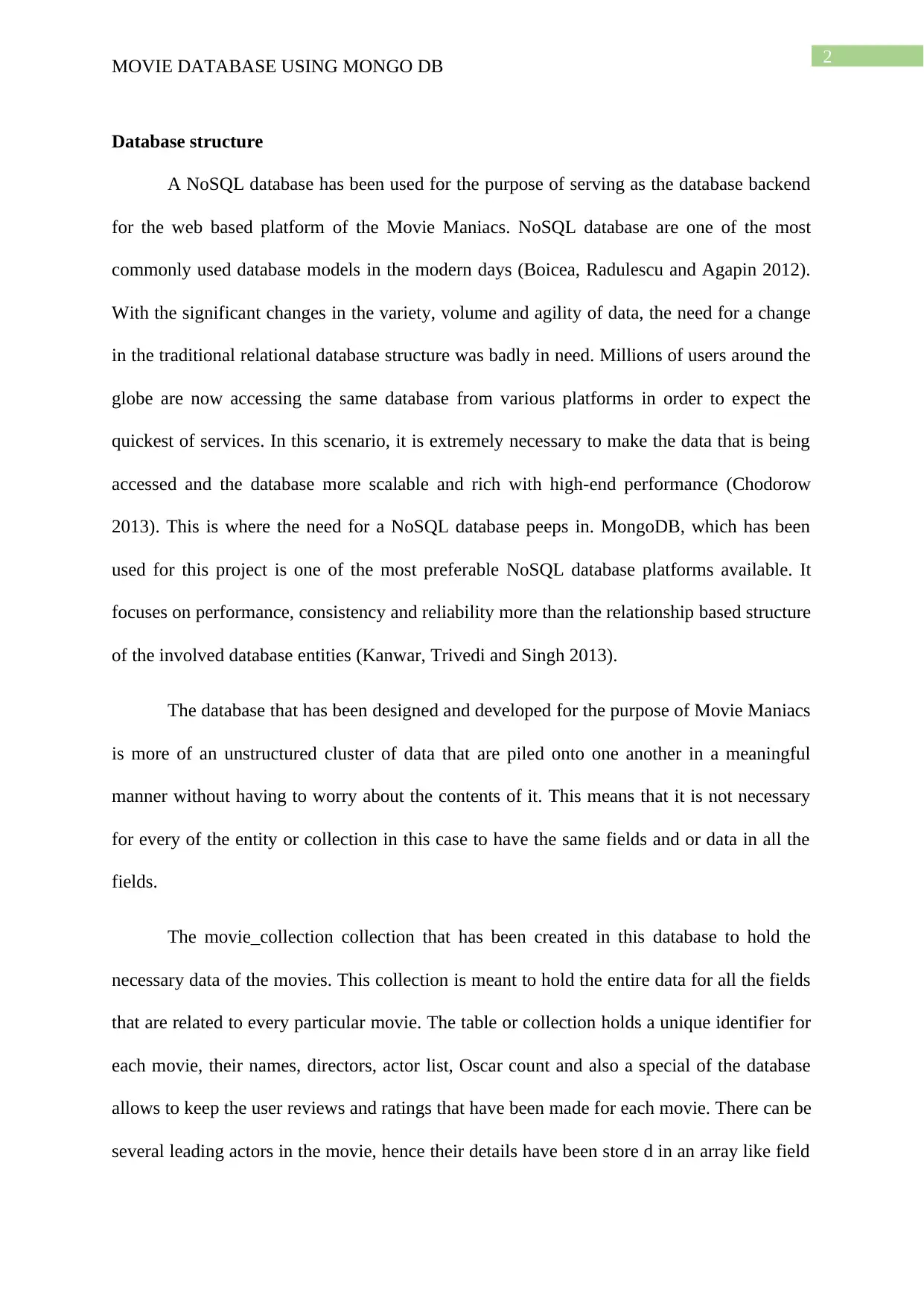
2
MOVIE DATABASE USING MONGO DB
Database structure
A NoSQL database has been used for the purpose of serving as the database backend
for the web based platform of the Movie Maniacs. NoSQL database are one of the most
commonly used database models in the modern days (Boicea, Radulescu and Agapin 2012).
With the significant changes in the variety, volume and agility of data, the need for a change
in the traditional relational database structure was badly in need. Millions of users around the
globe are now accessing the same database from various platforms in order to expect the
quickest of services. In this scenario, it is extremely necessary to make the data that is being
accessed and the database more scalable and rich with high-end performance (Chodorow
2013). This is where the need for a NoSQL database peeps in. MongoDB, which has been
used for this project is one of the most preferable NoSQL database platforms available. It
focuses on performance, consistency and reliability more than the relationship based structure
of the involved database entities (Kanwar, Trivedi and Singh 2013).
The database that has been designed and developed for the purpose of Movie Maniacs
is more of an unstructured cluster of data that are piled onto one another in a meaningful
manner without having to worry about the contents of it. This means that it is not necessary
for every of the entity or collection in this case to have the same fields and or data in all the
fields.
The movie_collection collection that has been created in this database to hold the
necessary data of the movies. This collection is meant to hold the entire data for all the fields
that are related to every particular movie. The table or collection holds a unique identifier for
each movie, their names, directors, actor list, Oscar count and also a special of the database
allows to keep the user reviews and ratings that have been made for each movie. There can be
several leading actors in the movie, hence their details have been store d in an array like field
MOVIE DATABASE USING MONGO DB
Database structure
A NoSQL database has been used for the purpose of serving as the database backend
for the web based platform of the Movie Maniacs. NoSQL database are one of the most
commonly used database models in the modern days (Boicea, Radulescu and Agapin 2012).
With the significant changes in the variety, volume and agility of data, the need for a change
in the traditional relational database structure was badly in need. Millions of users around the
globe are now accessing the same database from various platforms in order to expect the
quickest of services. In this scenario, it is extremely necessary to make the data that is being
accessed and the database more scalable and rich with high-end performance (Chodorow
2013). This is where the need for a NoSQL database peeps in. MongoDB, which has been
used for this project is one of the most preferable NoSQL database platforms available. It
focuses on performance, consistency and reliability more than the relationship based structure
of the involved database entities (Kanwar, Trivedi and Singh 2013).
The database that has been designed and developed for the purpose of Movie Maniacs
is more of an unstructured cluster of data that are piled onto one another in a meaningful
manner without having to worry about the contents of it. This means that it is not necessary
for every of the entity or collection in this case to have the same fields and or data in all the
fields.
The movie_collection collection that has been created in this database to hold the
necessary data of the movies. This collection is meant to hold the entire data for all the fields
that are related to every particular movie. The table or collection holds a unique identifier for
each movie, their names, directors, actor list, Oscar count and also a special of the database
allows to keep the user reviews and ratings that have been made for each movie. There can be
several leading actors in the movie, hence their details have been store d in an array like field
⊘ This is a preview!⊘
Do you want full access?
Subscribe today to unlock all pages.

Trusted by 1+ million students worldwide
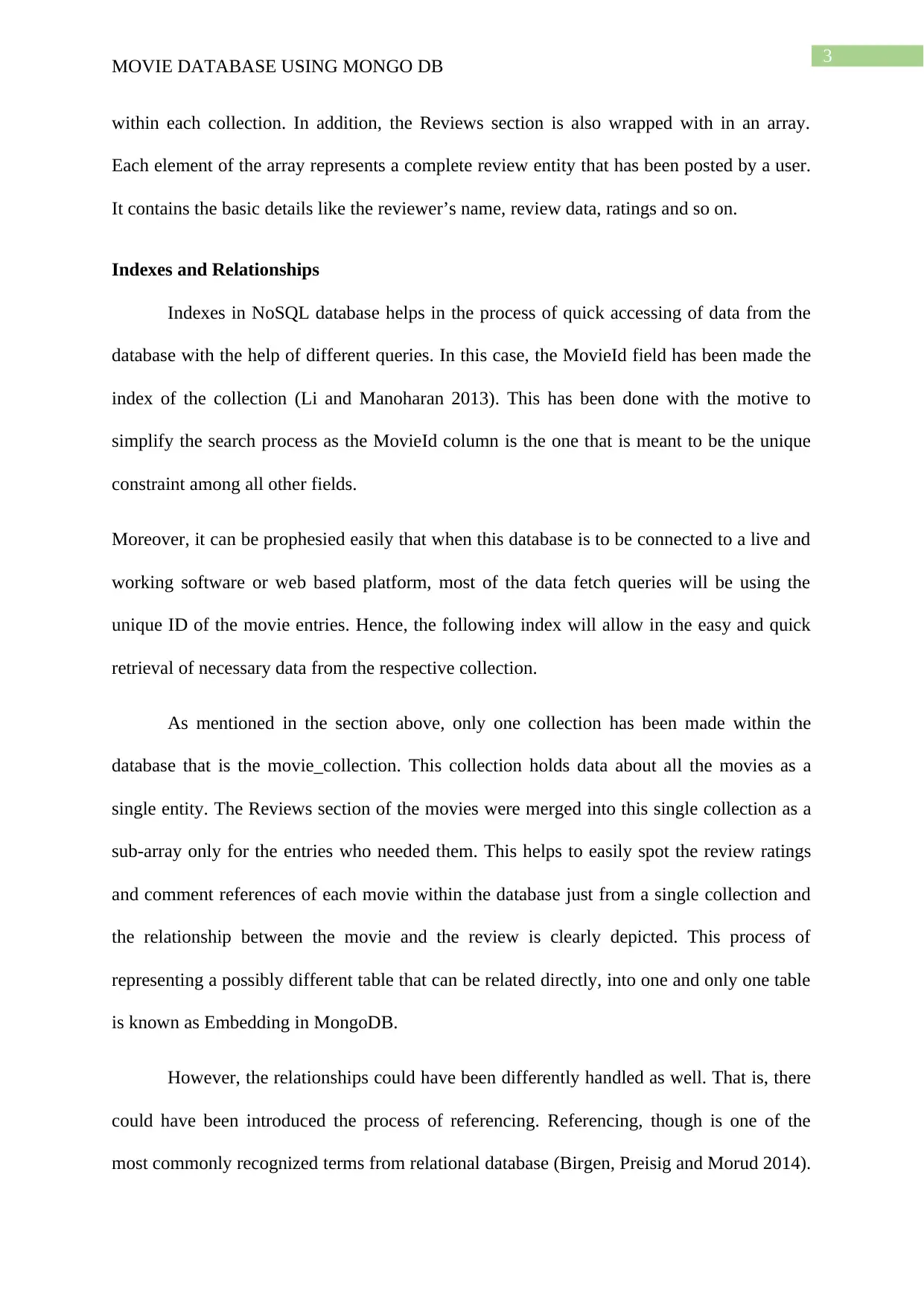
3
MOVIE DATABASE USING MONGO DB
within each collection. In addition, the Reviews section is also wrapped with in an array.
Each element of the array represents a complete review entity that has been posted by a user.
It contains the basic details like the reviewer’s name, review data, ratings and so on.
Indexes and Relationships
Indexes in NoSQL database helps in the process of quick accessing of data from the
database with the help of different queries. In this case, the MovieId field has been made the
index of the collection (Li and Manoharan 2013). This has been done with the motive to
simplify the search process as the MovieId column is the one that is meant to be the unique
constraint among all other fields.
Moreover, it can be prophesied easily that when this database is to be connected to a live and
working software or web based platform, most of the data fetch queries will be using the
unique ID of the movie entries. Hence, the following index will allow in the easy and quick
retrieval of necessary data from the respective collection.
As mentioned in the section above, only one collection has been made within the
database that is the movie_collection. This collection holds data about all the movies as a
single entity. The Reviews section of the movies were merged into this single collection as a
sub-array only for the entries who needed them. This helps to easily spot the review ratings
and comment references of each movie within the database just from a single collection and
the relationship between the movie and the review is clearly depicted. This process of
representing a possibly different table that can be related directly, into one and only one table
is known as Embedding in MongoDB.
However, the relationships could have been differently handled as well. That is, there
could have been introduced the process of referencing. Referencing, though is one of the
most commonly recognized terms from relational database (Birgen, Preisig and Morud 2014).
MOVIE DATABASE USING MONGO DB
within each collection. In addition, the Reviews section is also wrapped with in an array.
Each element of the array represents a complete review entity that has been posted by a user.
It contains the basic details like the reviewer’s name, review data, ratings and so on.
Indexes and Relationships
Indexes in NoSQL database helps in the process of quick accessing of data from the
database with the help of different queries. In this case, the MovieId field has been made the
index of the collection (Li and Manoharan 2013). This has been done with the motive to
simplify the search process as the MovieId column is the one that is meant to be the unique
constraint among all other fields.
Moreover, it can be prophesied easily that when this database is to be connected to a live and
working software or web based platform, most of the data fetch queries will be using the
unique ID of the movie entries. Hence, the following index will allow in the easy and quick
retrieval of necessary data from the respective collection.
As mentioned in the section above, only one collection has been made within the
database that is the movie_collection. This collection holds data about all the movies as a
single entity. The Reviews section of the movies were merged into this single collection as a
sub-array only for the entries who needed them. This helps to easily spot the review ratings
and comment references of each movie within the database just from a single collection and
the relationship between the movie and the review is clearly depicted. This process of
representing a possibly different table that can be related directly, into one and only one table
is known as Embedding in MongoDB.
However, the relationships could have been differently handled as well. That is, there
could have been introduced the process of referencing. Referencing, though is one of the
most commonly recognized terms from relational database (Birgen, Preisig and Morud 2014).
Paraphrase This Document
Need a fresh take? Get an instant paraphrase of this document with our AI Paraphraser
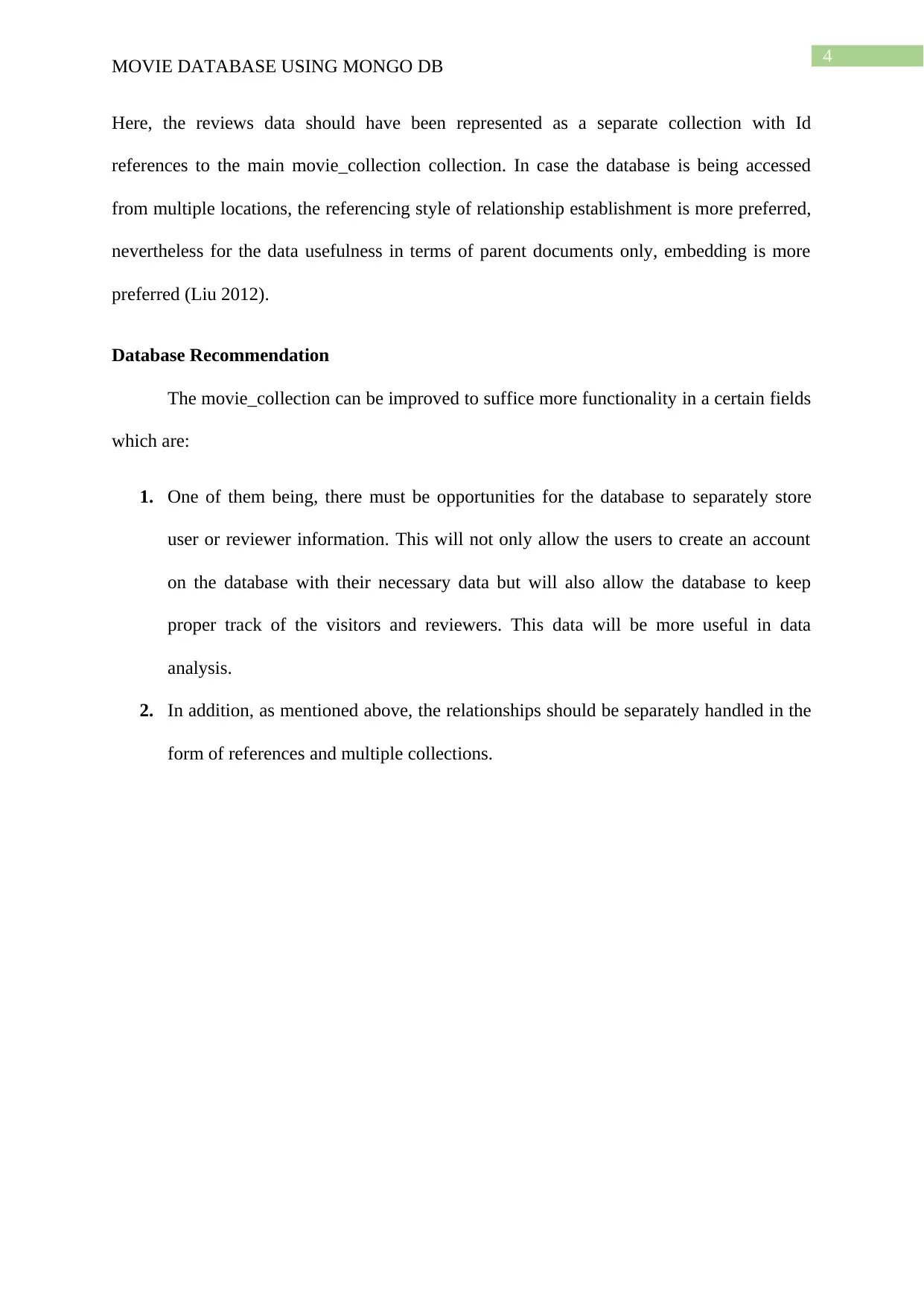
4
MOVIE DATABASE USING MONGO DB
Here, the reviews data should have been represented as a separate collection with Id
references to the main movie_collection collection. In case the database is being accessed
from multiple locations, the referencing style of relationship establishment is more preferred,
nevertheless for the data usefulness in terms of parent documents only, embedding is more
preferred (Liu 2012).
Database Recommendation
The movie_collection can be improved to suffice more functionality in a certain fields
which are:
1. One of them being, there must be opportunities for the database to separately store
user or reviewer information. This will not only allow the users to create an account
on the database with their necessary data but will also allow the database to keep
proper track of the visitors and reviewers. This data will be more useful in data
analysis.
2. In addition, as mentioned above, the relationships should be separately handled in the
form of references and multiple collections.
MOVIE DATABASE USING MONGO DB
Here, the reviews data should have been represented as a separate collection with Id
references to the main movie_collection collection. In case the database is being accessed
from multiple locations, the referencing style of relationship establishment is more preferred,
nevertheless for the data usefulness in terms of parent documents only, embedding is more
preferred (Liu 2012).
Database Recommendation
The movie_collection can be improved to suffice more functionality in a certain fields
which are:
1. One of them being, there must be opportunities for the database to separately store
user or reviewer information. This will not only allow the users to create an account
on the database with their necessary data but will also allow the database to keep
proper track of the visitors and reviewers. This data will be more useful in data
analysis.
2. In addition, as mentioned above, the relationships should be separately handled in the
form of references and multiple collections.
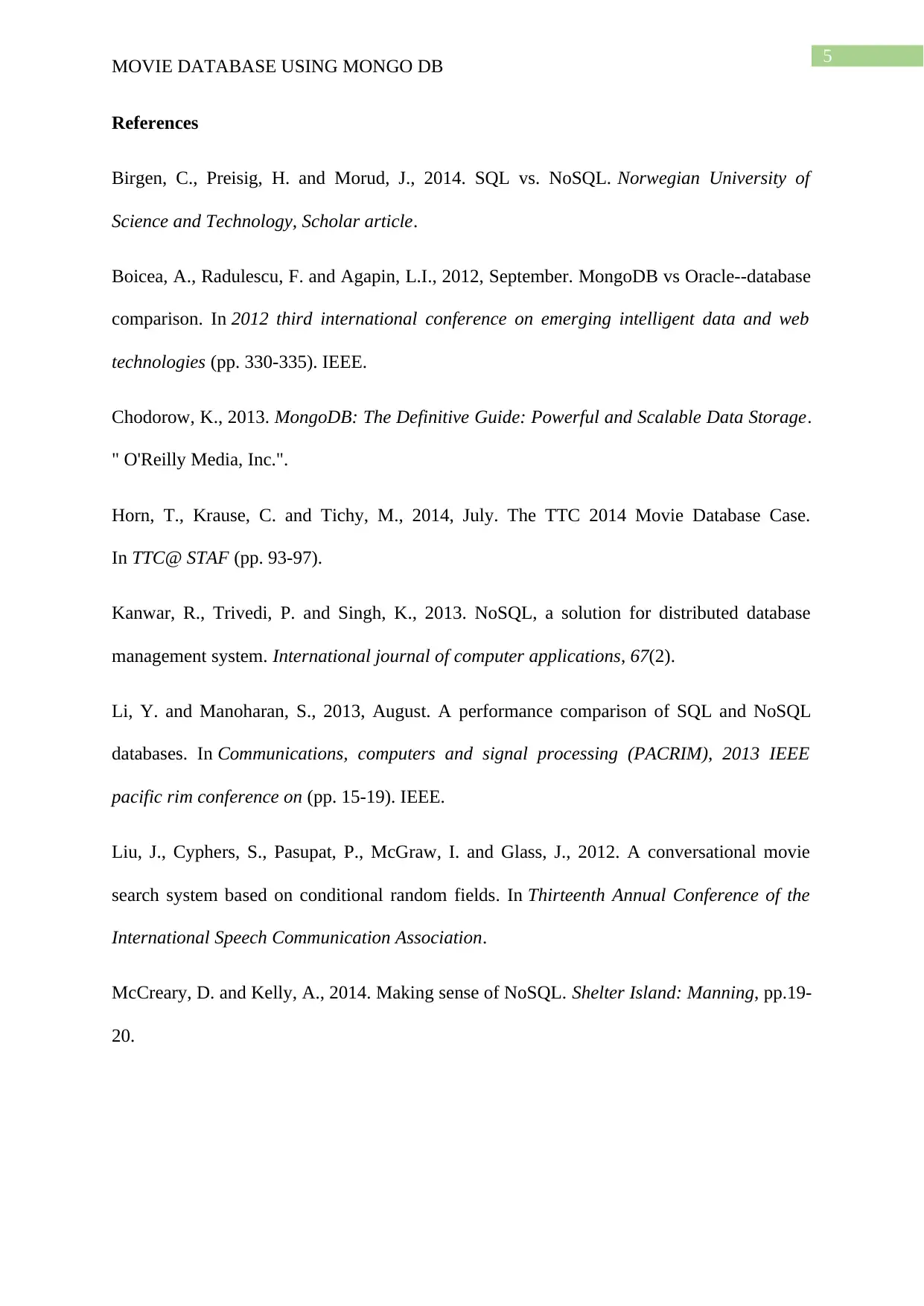
5
MOVIE DATABASE USING MONGO DB
References
Birgen, C., Preisig, H. and Morud, J., 2014. SQL vs. NoSQL. Norwegian University of
Science and Technology, Scholar article.
Boicea, A., Radulescu, F. and Agapin, L.I., 2012, September. MongoDB vs Oracle--database
comparison. In 2012 third international conference on emerging intelligent data and web
technologies (pp. 330-335). IEEE.
Chodorow, K., 2013. MongoDB: The Definitive Guide: Powerful and Scalable Data Storage.
" O'Reilly Media, Inc.".
Horn, T., Krause, C. and Tichy, M., 2014, July. The TTC 2014 Movie Database Case.
In TTC@ STAF (pp. 93-97).
Kanwar, R., Trivedi, P. and Singh, K., 2013. NoSQL, a solution for distributed database
management system. International journal of computer applications, 67(2).
Li, Y. and Manoharan, S., 2013, August. A performance comparison of SQL and NoSQL
databases. In Communications, computers and signal processing (PACRIM), 2013 IEEE
pacific rim conference on (pp. 15-19). IEEE.
Liu, J., Cyphers, S., Pasupat, P., McGraw, I. and Glass, J., 2012. A conversational movie
search system based on conditional random fields. In Thirteenth Annual Conference of the
International Speech Communication Association.
McCreary, D. and Kelly, A., 2014. Making sense of NoSQL. Shelter Island: Manning, pp.19-
20.
MOVIE DATABASE USING MONGO DB
References
Birgen, C., Preisig, H. and Morud, J., 2014. SQL vs. NoSQL. Norwegian University of
Science and Technology, Scholar article.
Boicea, A., Radulescu, F. and Agapin, L.I., 2012, September. MongoDB vs Oracle--database
comparison. In 2012 third international conference on emerging intelligent data and web
technologies (pp. 330-335). IEEE.
Chodorow, K., 2013. MongoDB: The Definitive Guide: Powerful and Scalable Data Storage.
" O'Reilly Media, Inc.".
Horn, T., Krause, C. and Tichy, M., 2014, July. The TTC 2014 Movie Database Case.
In TTC@ STAF (pp. 93-97).
Kanwar, R., Trivedi, P. and Singh, K., 2013. NoSQL, a solution for distributed database
management system. International journal of computer applications, 67(2).
Li, Y. and Manoharan, S., 2013, August. A performance comparison of SQL and NoSQL
databases. In Communications, computers and signal processing (PACRIM), 2013 IEEE
pacific rim conference on (pp. 15-19). IEEE.
Liu, J., Cyphers, S., Pasupat, P., McGraw, I. and Glass, J., 2012. A conversational movie
search system based on conditional random fields. In Thirteenth Annual Conference of the
International Speech Communication Association.
McCreary, D. and Kelly, A., 2014. Making sense of NoSQL. Shelter Island: Manning, pp.19-
20.
⊘ This is a preview!⊘
Do you want full access?
Subscribe today to unlock all pages.

Trusted by 1+ million students worldwide
1 out of 6
Related Documents
Your All-in-One AI-Powered Toolkit for Academic Success.
+13062052269
info@desklib.com
Available 24*7 on WhatsApp / Email
![[object Object]](/_next/static/media/star-bottom.7253800d.svg)
Unlock your academic potential
Copyright © 2020–2025 A2Z Services. All Rights Reserved. Developed and managed by ZUCOL.




